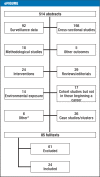Career Advice for Young Allergy Patients
- PMID: 27581504
- PMCID: PMC5012160
- DOI: 10.3238/arztebl.2016.0519
Career Advice for Young Allergy Patients
Abstract
Background: One-third of all young persons entering the work force have a history of atopic disease. Occupationally induced allergy and asthma generally arise in the first few months on the job, while pre-existing symptoms tend to worsen. Young persons with a history of an atopic disease should receive evidence-based advice before choosing a career.
Methods: We systematically searched PubMed for cohort studies investigating the new onset of asthma, rhinitis, or hand eczema among job trainees from before the start of training and onward into the first few years on the job. The search revealed 514 articles; we read their abstracts and selected 85 full-text articles for further analysis. 24 of these met the inclusion criteria.
Results: According to present evidence, atopy and a history of allergic disease (allergic rhinitis, atopic dermatitis) are the main risk factors for occupationally induced disease. The predictive value of a personal history of allergic diseases for the later development of an occupationally induced disease varies from 9% to 64% in the studies we analyzed. It follows that only young people with severe asthma or severe atopic eczema should be advised against choosing a job that is associated with a high risk of allergy, e.g., hairdressing or working with laboratory animals. Young people with a history of other atopic diseases should be counseled about their individual risk profile.
Conclusion: In view of the relatively poor predictive value of pre-existing atopic disease, secondary prevention is particularly important. This includes frequent medical follow-up of the course of symptoms over the first few years on the job. If sensitization or allergic symptoms arise, it should be carefully considered whether exposure reduction will enable the apprentice to stay on the job.
Figures
References
-
- Schmitz R, Thamm M, Ellert U, Kalcklösch M, Schlaud M. Verbreitung häufiger Allergien bei Kindern und Jugendlichen in Deutschland: Ergebnisse der KiGGS-Studie - Erste Folgebefragung (KiGGS Welle 1) Bundesgesundheitsblatt-Gesundheitsforschung-Gesundheitsschutz. 2014;57:771–778. - PubMed
-
- Stocks SJ, McNamee R, van der Molen HF, et al. Trends in incidence of occupational asthma, contact dermatitis, noise-induced hearing loss, carpal tunnel syndrome and upper limb musculoskeletal disorders in European countries from 2000 to 2012. Occup Environ Med. 2015;72:294–303. - PubMed
-
- Gautrin D, Ghezzo H, Infante-Rivard C, Malo JL. Host determinants for the development of allergy in apprentices exposed to laboratory animals. Eur Respir J. 2002;19:96–103. - PubMed
-
- Funke U, Fartasch M, Diepgen TL. Incidence of work-related hand eczema during apprenticeship: first results of a prospective cohort study in the car industry. Contact Dermatitis. 2001;44:166–172. - PubMed
-
- Visser MJ, Verberk MM, van Dijk FJ, Bakker JG, Bos JD, Kezic S. Wet work and hand eczema in apprentice nurses; part I of a prospective cohort study. Contact Dermatitis. 2014;70:44–55. - PubMed
Publication types
MeSH terms
LinkOut - more resources
Full Text Sources
Other Literature Sources
Medical
Miscellaneous


